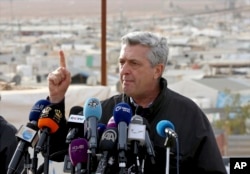Civilians can no longer flee fighting and bombing raids in Syria because borders are so tightly controlled and neighboring countries are overwhelmed by refugees, creating some of the worst suffering in modern times, a top U.N. agency chief said.
U.N. High Commissioner for Refugees Filippo Grandi was warning of a new disaster if the rebel-controlled Syrian city of Idlib was the next target of the Syrian military.
"The country is becoming a trap, in some places a death trap for civilians," Grandi told Reuters during a donor conference for Syria.
"There is an entire population out there that cannot bear its refugees anymore, that is suffering from one of the worse ordeals in modern history."
The Syrian Observatory for Human Rights, a British-based war monitor, said last month about 511,000 people had been killed in the war since it began in March 2011.
Some 5.5 million Syrians are living as refugees in Iraq, Jordan, Lebanon and Turkey, and now account for a quarter of Lebanon's population. Another 6.1 million people are still in Syria but have been forced to flee their homes.
Grandi is hoping to raise $5.6 billion from international donors for emergency humanitarian aid for Syrian refugees this year, but that money is not for Syria itself, instead going to help host countries such as Jordan, Iraq, Egypt and Lebanon.
Meanwhile, the United Nations estimates that more than 400,000 civilians are trapped in besieged areas throughout Syria.
That the number could rise dramatically because 2 million people live in the northwestern Idlib region, the largest populated area of Syria in the hands of insurgents fighting Syrian President Bashar al-Assad's government in Damascus.
Some aid agencies are predicting suffering on an even greater scale than during the siege of Aleppo last year and in eastern Ghouta and Raqqa this year if the Syrian army and its Russian and Iranian backers turn their full fire on Idlib.
Tens of thousands of fighters and civilians have fled to the area from parts of the country which the army has recaptured with the help of Russia and Iran.
"Idlib is where an area where a lot of fighters have transferred," Grandi said. "If fighting moves more decisively to that area, it could be very dangerous for civilians."
However, Grandi and other aid agencies predict they will have nowhere to flee to because Turkey's southern border with Syria at Gaziantep is tightly controlled, mainly letting aid supplies through to Idlib, forcing refugees deeper into Syria.
"I think we are going to lose not only a generation but a population," Grandi said.







